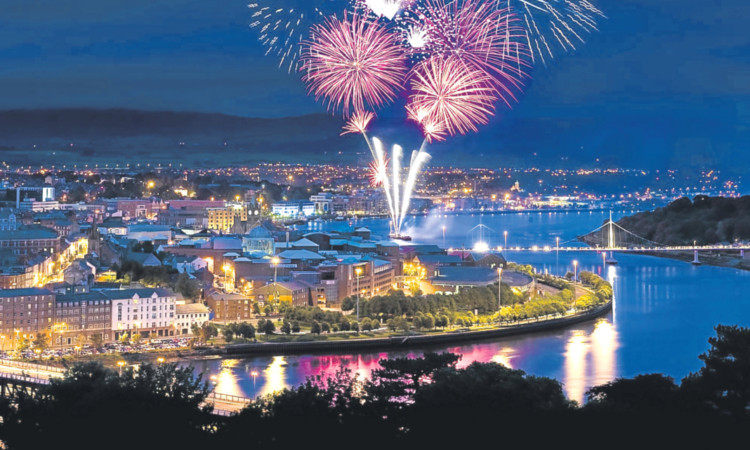
Whatever you choose to call it, Derry/Londonderry is a city of surprises.
New York was so good they named it twice.
Derry/Londonderry has two names for a less cheerful reason centuries of division. For the council, Republicans and most of history it’s been Derry. For Loyalists it’s still Londonderry. For official purposes it’s Derry/Londonderry, for lovers of irony it’s “Stroke City”, on road signs it’s the ”Walled City” and during its reign as UK City of Culture 2013, it’s been “LegenDerry.”
Despite growing up in Belfast, I only visited once years back. So I was completely unprepared for the funniest, most inspiring, affordable and memorable short break of the year when we arrived in early June during a mini-heatwave (flying Easyjet to Belfast International with a hire car for the 80 minute drive west.)
We were just in time for the spectacular highlight of Derry 2013 the imagined return of Saint Columba from Iona aboard a curragh rowed by 13 very real, hardy monks. Columba left Derry in 562AD after a medieval battle over copyright and produced the beautiful Book of Kells and Lindisfarne Gospels in exile.
Crowds howled with laughter as an acrobat playing Columba was suspended upside-down by his cassock from a giant airborne incense burner revealing scarlet pants. Not so long ago such “irreverence” would have been unthinkable. But thirty thousand people lined the Peace Bridge and leafy banks of the beautiful River Foyle for a “homecoming” which culminated in a lighting, fireworks and sound re-enactment of Columba’s mythic battle with the Loch Ness Monster.
For those worried about safety it’s reassuring to find the ultra-cautious American visitors everywhere encouraged to head north from Dublin by a cluster of world-class attractions the Belfast Titanic Centre, the Giant’s Causeway, the Ulster-American Folk Park near Omagh and now Derry the only Irish city with a complete set of medieval defensive walls.
Up until this year though, those Walls were hardly a visitor attraction. Scarred by ugly railings and heavy security gates for half a century, the walls had become a fiercely contested no-go zone marking the place King James II was denied entry to Derry prompting a siege, starvation and eventual defeat in 1690 for the King. But in a herculean peace effort, all gates and railings have been removed and the airy views, heady elevation, cleaned stonework, glimpses of restored ancient churches and outdoor cafes mean Derry’s Walls are now a free, unique, safe and memorable highlight of any stay.
During a poignant and generally hilarious 90 minute walking tour of the entire walls from which you can see the famous Bogside murals our Catholic guide Martin McCrossan spotted the Protestant Director of the Apprentice Boys Organisation and asked him to relate his “side of the story.” It was a real “Chuckle Brothers” moment surpassed only by emotional locals shaking hands with camera-carrying visitors and guide Gerry Lynn offering a bespoke two hour tour of the fascinating Tower Museum “Och it was quiet today anyway”.
From the Walls we spotted a barbers called Baldies minutes later my husband Chris was having the “haircut of his life” from a tattooed barber with a big smile and an incomprehensible local accent. Outside bustling shops, galleries and streets showcased other aspects of Derry’s story a century of top-class shirt-making, an accidental landing by Amelia Earhart, the surrender of the German U-boat fleet at the end of World War Two, and the stranding of “Dopey Dick” (a killer whale caught in the fast-flowing waters forty years ago.)
Of course, old divisions remain. Flags, slogans and street names are testimony to that. But there’s no edginess and no discernible tension. The Fleadh brought 300 thousand visitors to Derry this summer the first time the world’s biggest celebration of Irish music had ever been held in Northern Ireland. Indeed, the advantage of Derry’s location on the Irish border is easy access to the fabulous scenery of Donegal.
We dined at Browns Champagne Restaurant and stayed at the bustling Everglades Hotel in Derry, the lovely Beech Hill Country House Hotel near the border and McGrory’s Hotel in Culdaff on the relatively undiscovered Inishowen peninsula. After a long, unhurried, typically Irish conversation with McGrory’s owner Neil about archaeology in this cosy epicentre of Irish traditional food and music, we set off on a 50 km tour of Donegal country lanes and steep cliff-tops with local lass Blaise Harvey. The bikes were brand new, the pace easy, the craic brilliant and the views stunning. But the unexpected reward was a perfect Caf Latte at the Caffe Bamba cabin perched cheekily atop the mighty cliffs of Malin Head where Dominic a former oil engineer turned barista — serves coffee, home-baking, directions and general thoughts on the universe.
Mercifully we saved ourselves for lunch at the splendid Seaview Tavern fresh langoustine prawns and seafood soup served by the redoubtable host Michael Doherty complete with more thigh-slapping tales and general joie de vivre. We came back later to visit the astonishing Famine Village at Doagh a private, self-built museum featuring re-enactments of a traditional Irish Wake, an authentic Orange Hall and a Republican “Safe House” where you can trace the Peace Process through secret doorways and hidden rooms.
Colourful, genuine and slightly gobsmacked by its stunning success in 2013 Derry is on the up and up. Donegal is the city’s perfect partner. The Year of Culture is almost over but 2014 is action packed too. So why not get over?
More information at www.derryvisitor.com and www.ireland.com

Enjoy the convenience of having The Sunday Post delivered as a digital ePaper straight to your smartphone, tablet or computer.
Subscribe for only £5.49 a month and enjoy all the benefits of the printed paper as a digital replica.
Subscribe